As the national birds of the United States, bald eagles are one of the best-known birds around. They are large birds of prey that are widespread and abundant across the US. Bald eagles are easily recognized by their distinctive appearance and massive wingspan. However, bald eagles are also known for creating the largest nest of any bird in the world. But just how big do their nests get? Join us as we discover the largest bald eagle nest ever found!
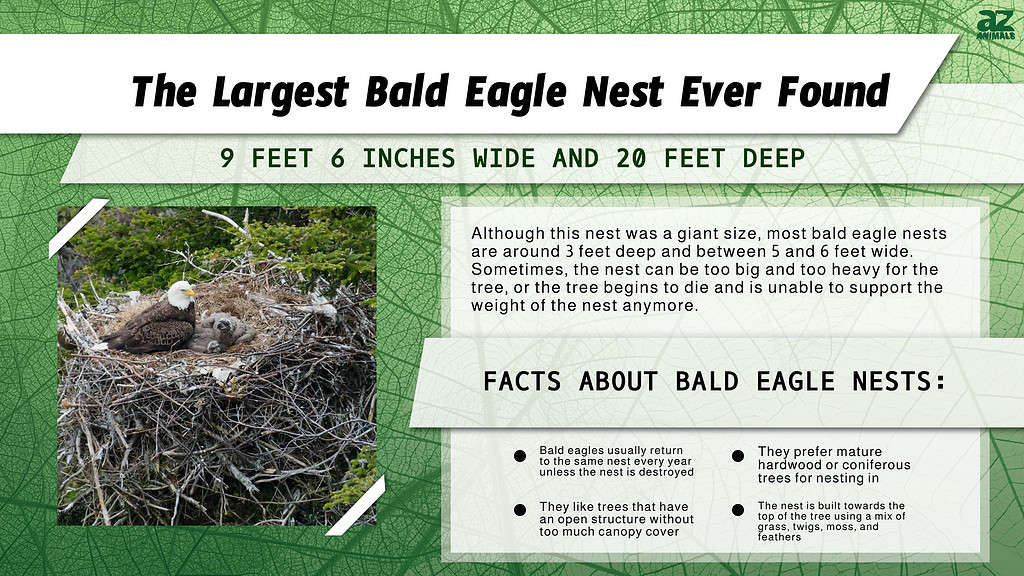
About Bald Eagles
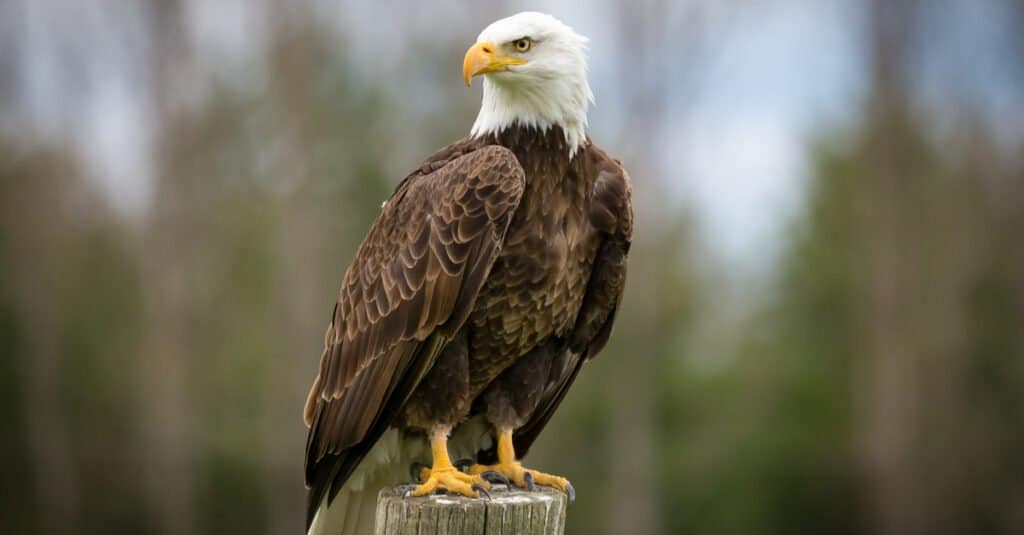
Bald eagles are notorious predators.
©iStock.com/emranashraf
Bald eagles are sea eagles from the Accipitridae family group, which includes eagles, hawks, kites, harriers, and Old World vultures. Despite their name, bald eagles (Haliaeetus leucocephalus) are not actually bald. Instead, their name comes from an older word for “white-headed”. Bald eagles are large birds with dark brown bodies and white heads.
They have a massive wingspan which ranges between 5ft 11in and 7ft and weigh anything up to around 14 pounds. Females are usually 25% larger than males. Interestingly, the size of bald eagles corresponds with their distance from the Equator – with larger birds being found further away from it. Alaska, in particular, has some of the largest bald eagles in the US.
Bald eagles live near large bodies of water where food is abundant, and there are plenty of trees for them to build their nests. Habitats include coastlines, rivers, and large lakes. As bald eagles are so large, they need trees that are strong enough to support them and their nests. Therefore, bald eagles prefer mature coniferous or hardwood trees located near water.
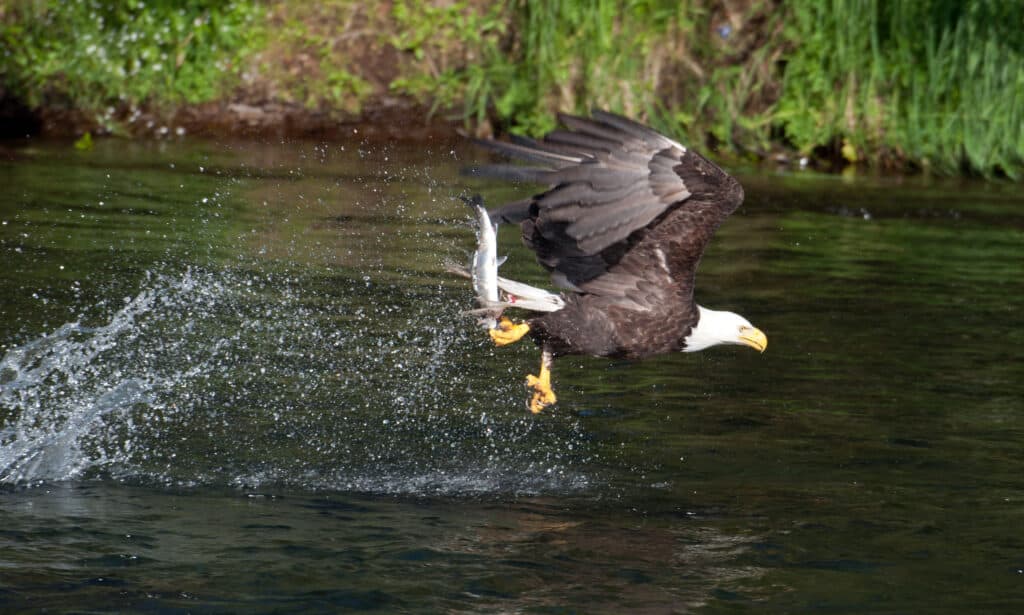
Bald eagles are skilled at fishing and prefer to make their nests near water.
©Tony Campbell/Shutterstock.com
Bald eagles are opportunistic feeders. Although they predominantly eat fish, they also eat other birds (particularly water birds) and mammals such as rodents, rabbits, hares, beavers, and even young deer. Bald eagles are strong fliers and can reach speeds of around 100mph. They catch fish by swooping down and seizing them in their talons and can carry fish almost as heavy as themselves. Birds as large as Canada geese are attacked mid-flight. However, sea birds that live in burrows, such as shearwaters and storm petrels are dug out of their burrows and killed. Bald eagles are such notorious predators of sea birds that many species instantly fly away the moment they see a bald eagle nearby.
The Largest Bald Eagle Nest Ever Found
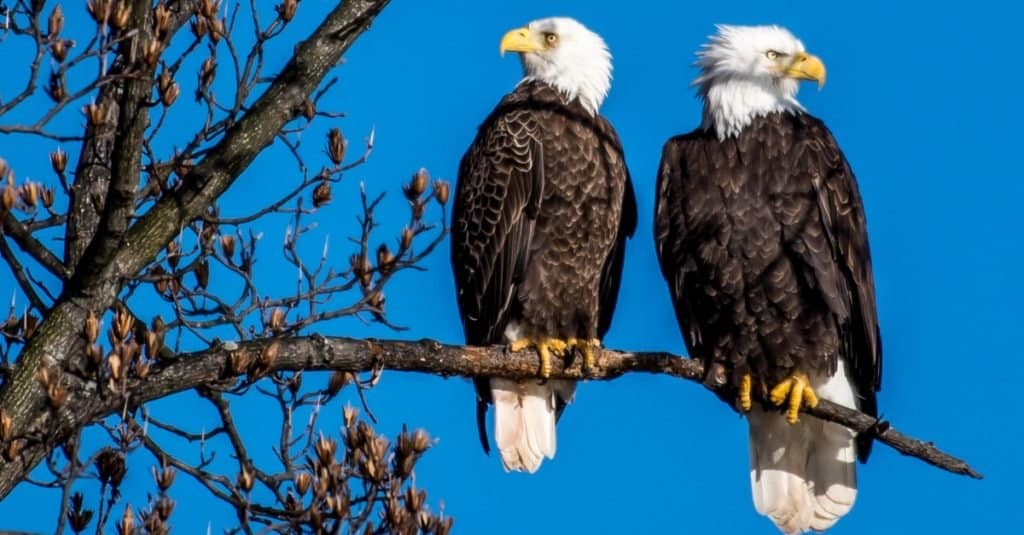
The largest bald eagle nest was 9.6 feet wide and 20 feet deep!
©Krumpelman Photography/Shutterstock.com
The largest bald eagle nest ever found was 9 feet 6 inches wide and 20 feet deep! Incredibly, it also weighed around 4,400 pounds! This massive nest was found in St. Petersburg, Florida in 1963 and was built by a pair of bald eagles.
Is It Normal For Eagle’s Nests To Be So Big?
Although this nest was a giant size, most bald eagle nests are around 3 feet deep and between 5 and 6 feet wide. Sometimes, the nest can be too big and too heavy for the tree, or the tree begins to die and is unable to support the weight of the nest anymore. If this happens, then the tree can collapse under the weight. It can also happen if the nest is made heavier by rain or snow.
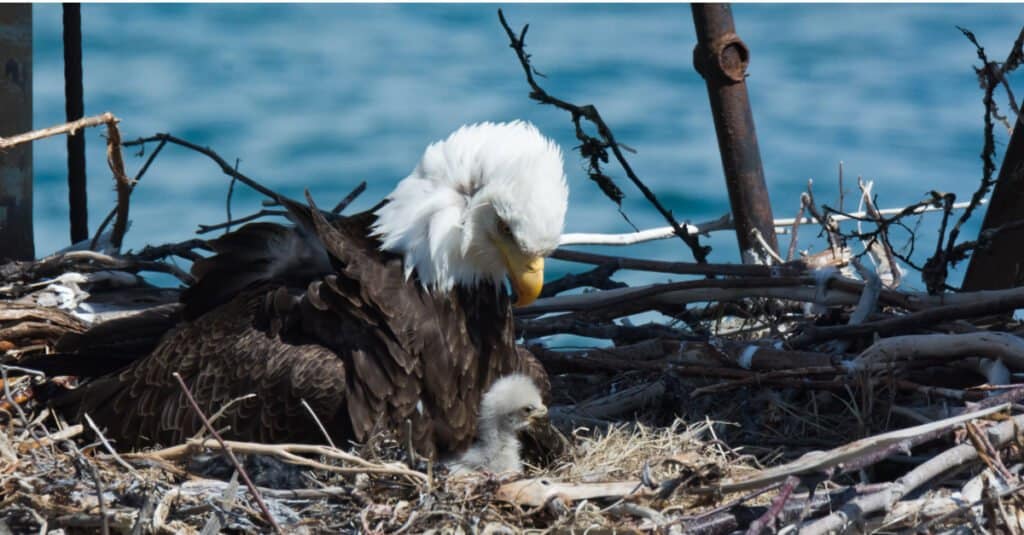
The most common trees that bald eagles nest in are cottonwood trees and white pines.
©Jon C. Beverly/Shutterstock.com
However, the humongous size of this nest raises the question of just how it managed to get to such a record-breaking size. The key to the answer is that it was likely used for many, many years. As bald eagles mate for life, they usually return to the same nest every year unless the nest is destroyed. In fact, this is the reason that bald eagle nests can end up in such giant sizes! Every year, bald eagles return to the nest and add between one and two feet of new material to the nest. This means that the nest builds up gradually over time.
What Makes A Suitable Nest?
As we’ve already mentioned, bald eagles prefer mature hardwood or coniferous trees for nesting in. The most common trees that bald eagles nest in are cottonwood trees and white pines. However, oaks, aspens, and fir trees are also used. Despite this, it’s not just the type of tree that’s important, as there are a few other things that make them suited for nesting.
Bald eagles like to nest in trees that allow them to have good visibility and be close to where there is plenty of prey. Therefore, most of the time, they only nest in trees taller than 66 feet. They also like trees that have an open structure without too much canopy cover. Quite often, nests can be anything from 52 feet all the way up to 125 feet above the ground.
Nest building begins up to three months before the eggs are laid. Once a suitable site for the nest has been found, both the male and female help to build it, although the female generally gathers the materials. The nest is built towards the top of the tree using a mix of grass, twigs, moss, and feathers. Bald eagles also tend to keep small pieces of fresh greenery in and around the nest. It’s not certain why they do this, but one theory is that it shows that the nest is occupied. Also, feathers or soft bits of moss and grass are used to line the nest in a bowl shape. This insulates the nest and prevents the eggs – and eventually chicks – from falling out.
Nesting
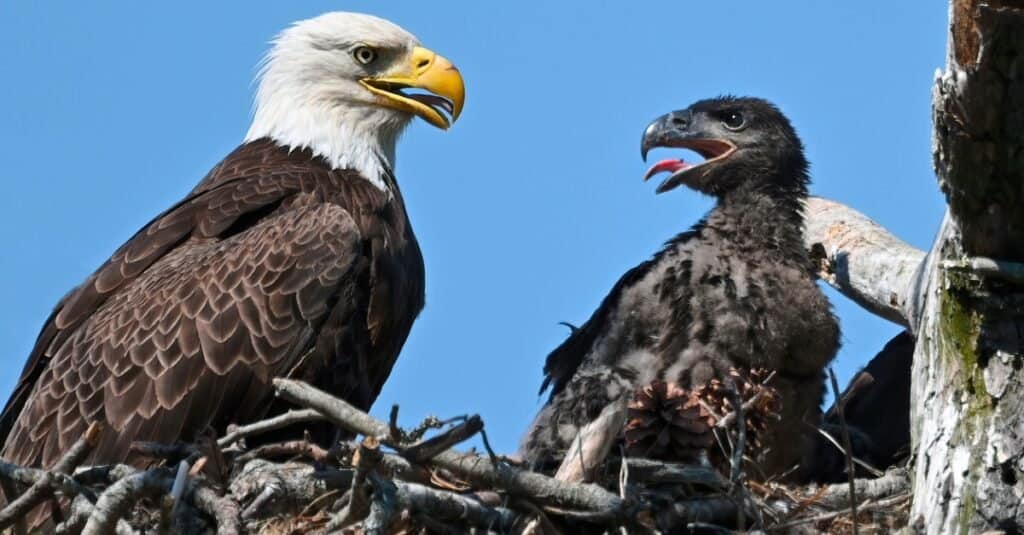
Bald eagles share parenting duties and bring chicks food until they are fully independent.
©iStock.com/BrianEKushner
Bald eagles lay between one and three eggs over a period of three to six days. Again, both parents share the duties of incubating the eggs. However, the male tends to go hunting and provide food while the female is nesting. This is because males are slightly better hunters than females as they are smaller.
The eggs take 35 days to hatch with one parent remaining in the nest at all times. After hatching, the chicks still remain in the safety of the nest for many weeks. Once the chicks have been born both the male and the female feed them. They bring food back to the nest and tear it up for the young to eat.

Both male and female bald eagles share feeding duties.
©Krumpelman Photography/Shutterstock.com
Bald eagle chicks begin to fly after several weeks in the nest and start off with short flights back and forth. However, they are not fully fledged until they are around 12 weeks old. Despite this, the parents continue to feed them for up to 10 weeks after they have left the nest until they can learn to be fully independent. Although adults don’t have any natural predators, nest predators include raccoons, bears, and bobcats.
Where is St. Petersburg Located on a Map?
In 1963, a massive eagle nest was found in St. Petersburg, Florida. A pair of eagles built it, and it was 4,400 pounds! St. Petersburg is a city on Florida’s Gulf Coast, part of the Tampa Bay area. Other than the bay, its main body of water is the Gulf of Mexico. It is known for its pleasant weather for golfing, boating, fishing, and beachgoing.
The photo featured at the top of this post is © Jack Molan/Shutterstock.com
Thank you for reading! Have some feedback for us? Contact the AZ Animals editorial team.






